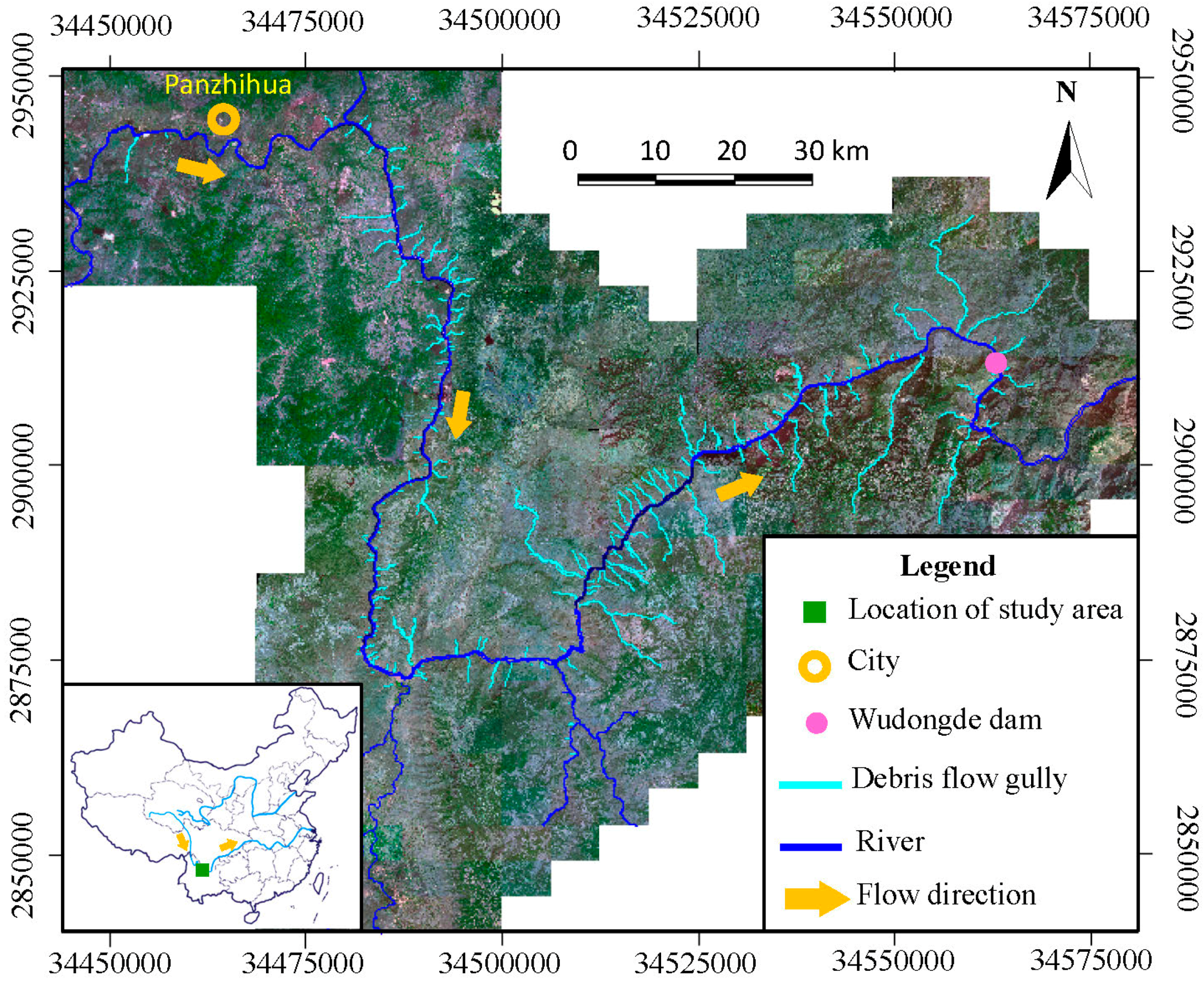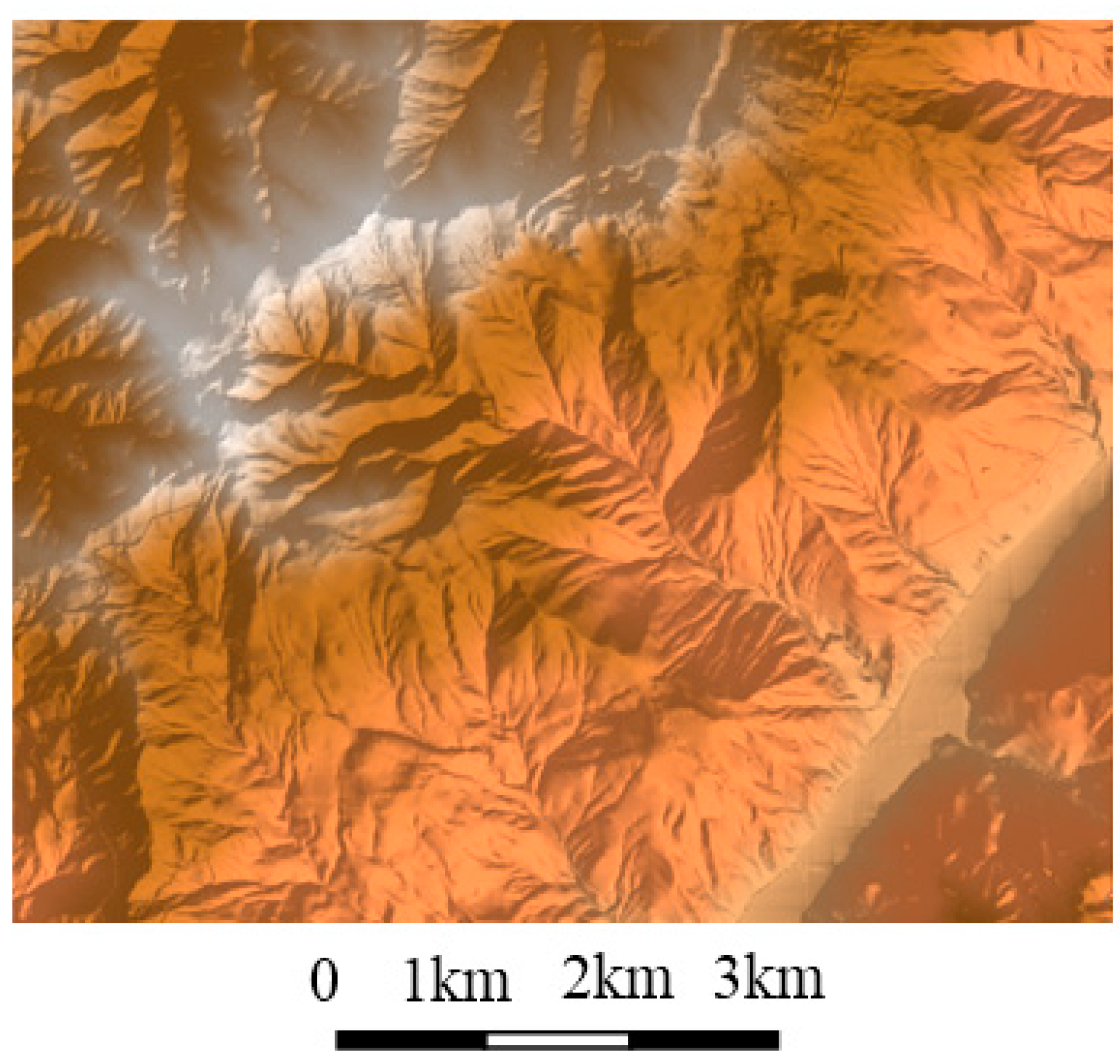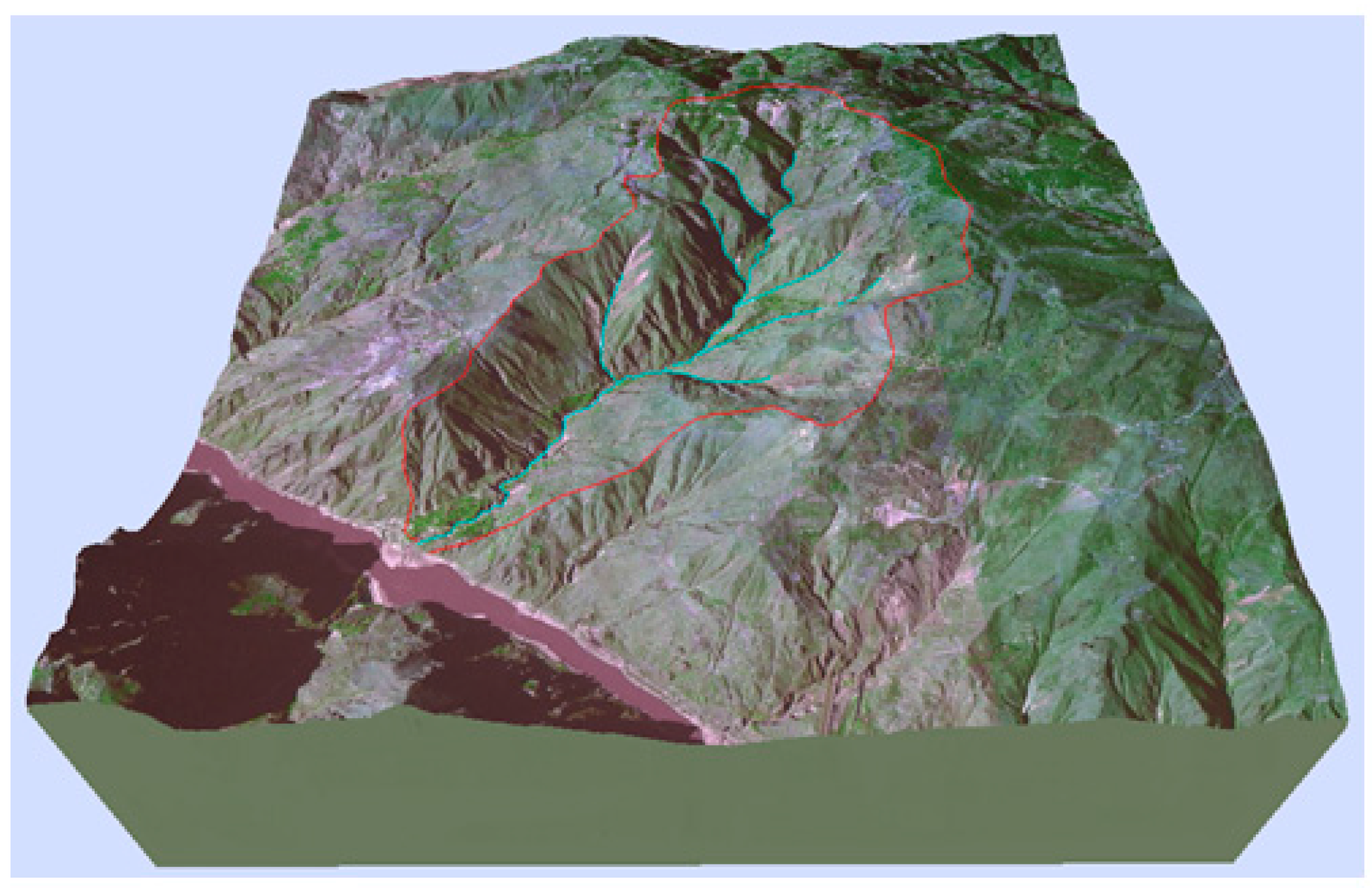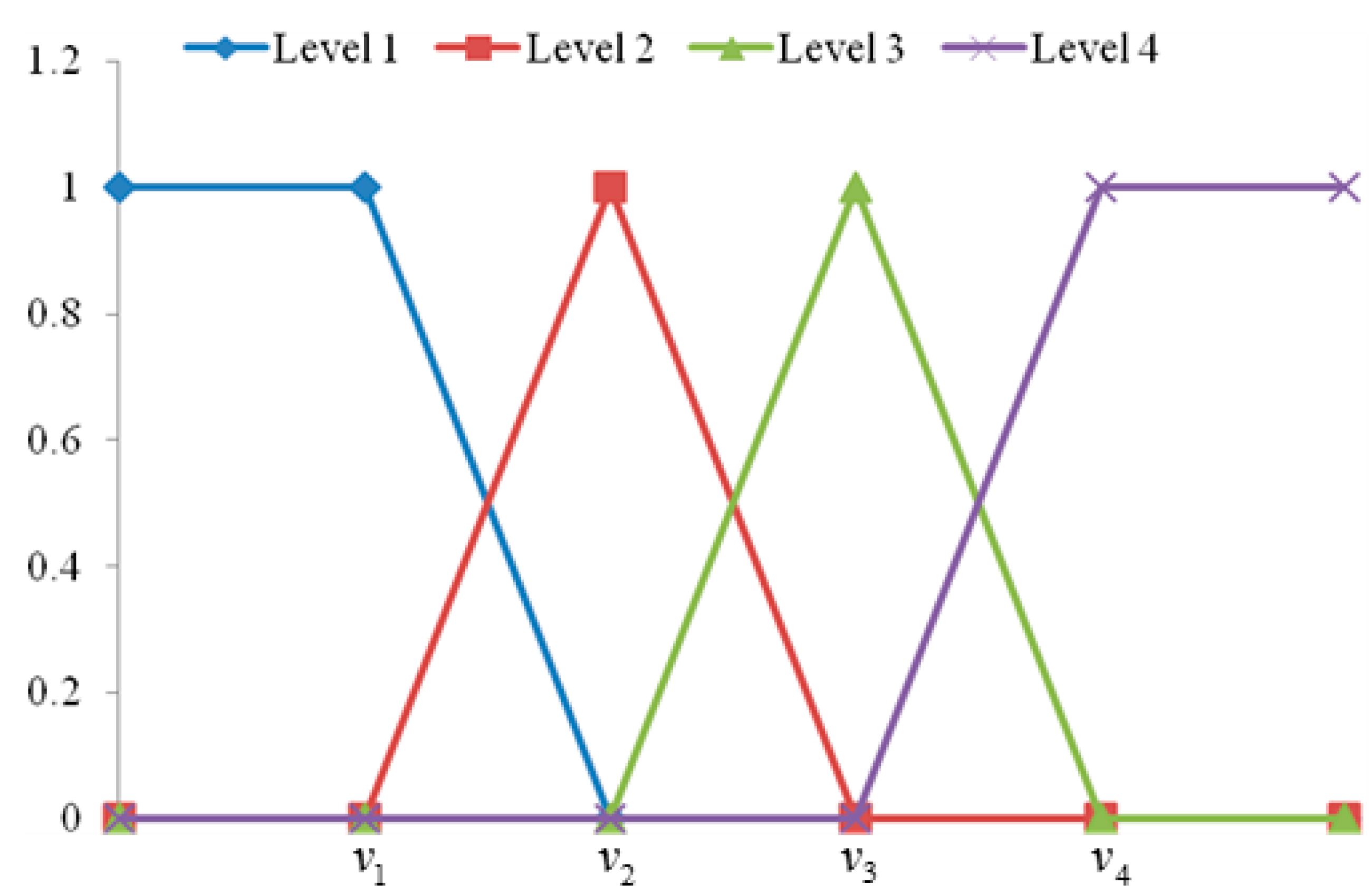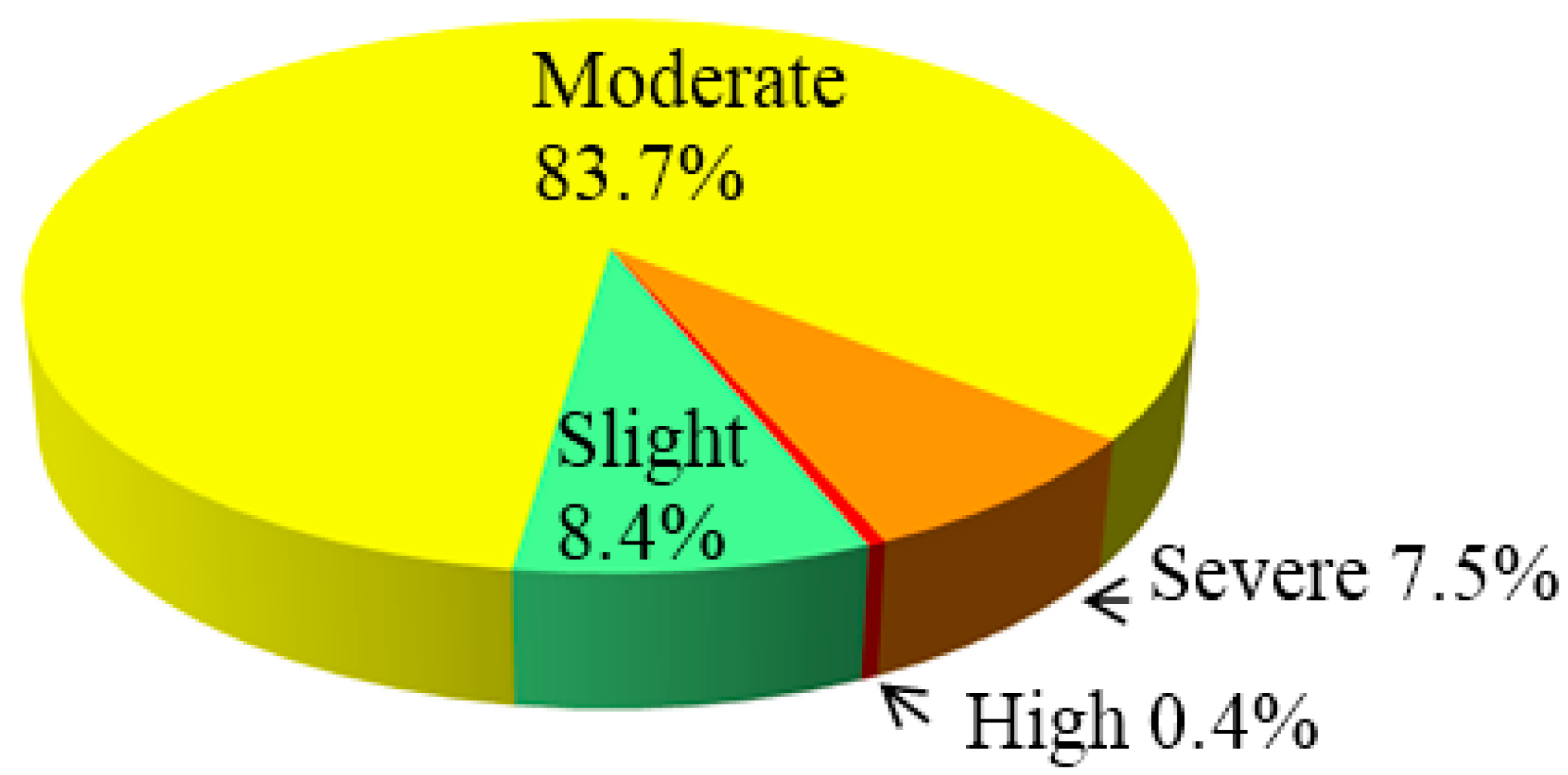4.2. Influencing Factors
The hazard degree of debris flows is determined by their characteristics. Thus, the choice of influencing factors is critical to the assessment results. Liu [
12] conducted a questionnaire survey to determine the primary influencing factors according to experts in the field of debris flow. After analyzing the survey results using the grey relation analysis, he proposed that magnitude and frequency are the two primary influencing factors. Liu then studied the relationship between the primary and secondary influencing factors using the grey relation theory and determined eight secondary influencing factors. These secondary influencing factors include the basin area, main channel length, maximum elevation difference, ravine density, main channel sinuosity, active main channel proportion, maximum daily rainfall, and population density. These ten factors are introduced in detail as follows:
(1) Debris flow magnitude M
Debris flow magnitude refers to the maximum depositional volume of a debris flow. This parameter can be represented by the maximum single debris flow deposits in the depositional area. Hungr
et al. [
38] considered the discharge volume to be a comprehensive index that reflects the degree of hazard of debris flows.
(2) Frequency F
Frequency is the number of debris flow occurrence in 100 years. The higher the debris flow frequency, the higher the probability of debris flow hazards. Frequency is a direct indicator of debris flow hazard and should also be considered as a primary influencing factor. The value is then scaled to the occurrence times 100 years regardless of the time span. Frequency is obtained through a number of related history records, literature review, and local geological data. Frequency can also be obtained through interviews with local elders, considering landscape changes and associated consequences faced by local communities. Thereby, we could obtain the outbreak of debris flow near the village.
(3) Basin area S1
Basin area reflects the volume of the loose material and collected water. The basin area is generally directly proportional to the volume of the loose material and collected water [
39].
(4) Main channel length S2
A greater main channel length results in greater flow length and influx of loose material along the channel. Therefore, the main channel length is an influencing factor.
(5) Maximum elevation difference S3
Maximum elevation difference is the elevation difference between the highest and the lowest points in a watershed. This value reflects the potential energy of a debris flow. A larger maximum elevation difference generally results in a larger potential energy and greater destructive force of debris flow.
(6) Ravine density S4
Ravine density is the ratio of the total ravine length to the basin area. This value comprehensively reflects the geological structure, lithology, and degree of rock weathering because ravines commonly develop in weak areas. With an increase in ravine density, the volume of debris flow increases [
19,
20].
(7) Main channel sinuosity S5
Main channel sinuosity is the ratio of the actual length to the linear length of the main channel. This value reflects the blockage of a debris flow gully. A larger value indicates that a channel is easier to block. This value also indirectly reflects the flow volume.
(8) Active main channel proportion S6
The active main channel proportion is the ratio of the length of the portion of the channel containing loose material to the total channel length. This value comprehensively reflects the supply range and volume of loose material.
(9) Maximum daily rainfall S7
Water is an important component of debris flows, and rainfall triggers the occurrence of such phenomena. The maximum daily rainfall reflects the potential kinetic energy of debris flows.
(10) Population density S8
Population density and occurrence of debris flows are closely related. Human activity, such as deforestation and slope cutting, seriously accelerates the formation and development of debris flows.
In this study, the above-mentioned ten influencing factors are chosen for the hazard assessment of debris flows. Based on grey relation theory, Liu determined the order of importance of these ten factors as follows: M = F > S1 > S4 > S2 > S3 > S6 > S7 > S8 > S5.
4.3. Analytic Hierarchy Process
In the evaluation process, the weight of each influencing factor is critical to the assessment result. Hence, the validity of the weights must be ensured. The Analytic Hierarchy Process (AHP), as proposed by Saaty [
23,
24], is an effective measure to determine the weight set. The process is as follows:
(1) Structure of the judgment matrix
The AHP method builds on pairwise comparison to determine the relative importance of one factor over another. The matrix of pairwise comparisons for
n factors can be written as:
where
represents the comparison of factor
to factor
, and
denotes the relative importance of factor
with respect to factor
.
A numerical scale is necessary to indicate the magnitude of the importance of one factor over another. The classical 1–9 scale is applied in this work because of its advantages of good original order-keeping, uniformity of scale and perceptibility [
40]. The scale is shown in
Table 2.
Table 2.
The 1–9 pairwise comparison scale.
Table 2.
The 1–9 pairwise comparison scale.
| Intensity of Weight | Definition | Explanation |
|---|
| 1 | Equal importance | Two factors contribute equally to objectives |
| 3 | Weak/moderate importance of one over another | Experience and judgment slightly favored one factor over another |
| 5 | Essential or strong importance | Experience and judgment strongly favor one factor over another |
| 7 | Very strong or demonstrated importance | One factor is favored very strongly over another; its dominance demonstrated in practice |
| 9 | Absolute importance | Evidence favoring one factor over another is of the highest possible order of affirmation |
| 2,4,6,8 | Intermediate values between the two adjacent scale values | Used to represent compromise between the priorities listed above |
| Reciprocals of above non-zero numbers | | If factor i has one of the above non-zero numbers assigned to it when compared to factor j, then factor j has the reciprocal value when compared with factor i |
(2) Calculation of the weight set
The weight of
is obtained using the row geometric mean method [
41].
The weight set
is normalized according to the following:
From this normalized set of weights, the priority or importance of the factors is obtained.
(3) Verification of consistency
To guarantee that the judgments are reasonable, consistency verification should be conducted. The consistency index
is given by:
where
is the largest eigenvalue of the judgment matrix and
is the order of the matrix.
The criterion of the consistency verification is given by:
where
can be obtained from the value table of the consistency index
. The values of
when the order of the matrix is between 3 and 10 are listed in
Table 3. When
is less than 0.1, the judgment matrix
can be considered completely consistent. If
is larger, the matrix should be modified to satisfy the consistency check.
Table 3.
The values of consistency index RI.
Table 3.
The values of consistency index RI.
| Order | 3 | 4 | 5 | 6 | 7 | 8 | 9 | 10 |
|---|
| RI | 0.58 | 0.90 | 1.12 | 1.24 | 1.32 | 1.41 | 1.45 | 1.49 |
4.4. Fuzzy Synthetic Evaluation
The following procedure describes the Fuzzy Synthetic Evaluation (FSE) method.
(1) Selection of factor set U: U = {ui}, i = 1, 2,…, n.
where
n is the number of selected evaluation factors. In this study,
n is equal to 10 and the details of the ten factors are given in
Section 4.2.
(2) Construction of the evaluation criteria set V: V = {vj}, j = 1, 2,…, m.
where
is number of evaluation criteria categories, and
is the threshold of the
jth criteria category. The details of the threshold of each factor used in this study are given in
Section 4.2. In this study, the outputs of hazard assessment are classified into four levels: slight, moderate, severe and high. Therefore, we choose
, and
.
(3) Establish membership functions
In fuzzy logic, the set A is defined in terms of its membership function by
. where
is a domain, with a generic element of
denoted by
;
is the membership function of the set
, which maps the domain
onto the interval [0,1], and
represents the degree that
belongs to set
.
is a full member of
when
, is not member of
when
, and is a partial member of
when
[
42].
The membership functions of each assessment factor to the assessment criteria at each level can be described quantitatively by a set of formulas. The factors directly proportional to the hazard degree are called increasing factors. By contrast, the factors inversely proportional to the hazard degree are called decreasing factors. The membership functions of increasing factors are different from those of decreasing factors. All the factors chosen in this study are increasing factors. Therefore, the membership functions of the increasing factors are given as follows:
where
is the number of assessment factors (
i = 1, 2,…, 10);
is the number of assessment criteria levels (
j = 1, 2, 3, 4);
is the actual value of assessment factor
;
,
, and
are the assessment criteria threshold of the
ith assessment factor at levels
,
and
, respectively; and
is the membership degree of assessment factor
at level
. The constructed membership functions for the factors are shown in
Figure 6.
Figure 6.
Ten influencing factors’ membership functions.
Figure 6.
Ten influencing factors’ membership functions.
(4) Calculation of fuzzy relationship matrix
Substituting the data of each assessment factor and the gradation criteria into the constructed membership functions above, the fuzzy matrix
can be expressed as follows:
where
is the membership degree of the
ith assessment factor to the assessment criteria at
jth level. In this study,
;
; (
i = 1, 2,…, 10); and (
j = 1, 2, 3, 4).
(5) Determination of the weight set
The weight set is obtained using the AHP method.
(6) Calculation of the relative importance set
where
and
are the weight set and the fuzzy relationship matrix determined above, respectively; * is a fuzzy composite operator; and B is a fuzzy set. The fuzzy composite operator is critical and affects the final evaluation results. The weighted average fuzzy composite operator is used widely in a variety of resource and environmental evaluation systems [
43,
44]. The weighted average fuzzy composite is shown in the following equation:
(7) Determination of the final evaluation result
The final evaluation result is determined by the following equation: Level = max{b1, b2, …, bm}. where the maximum value of determines the level of hazard degree.
